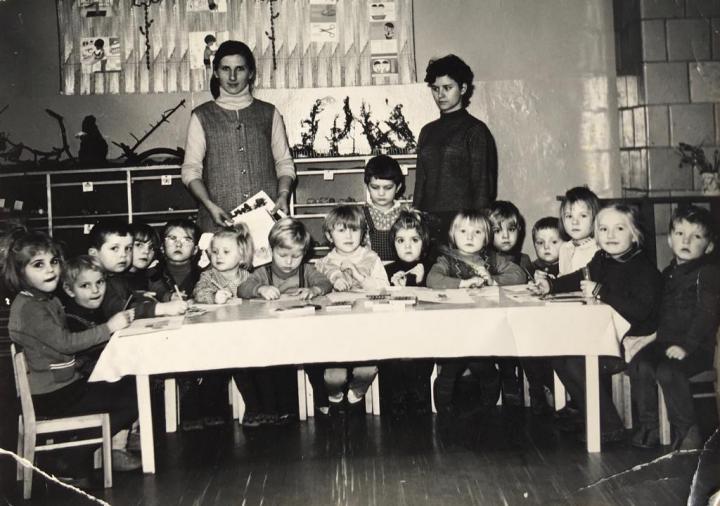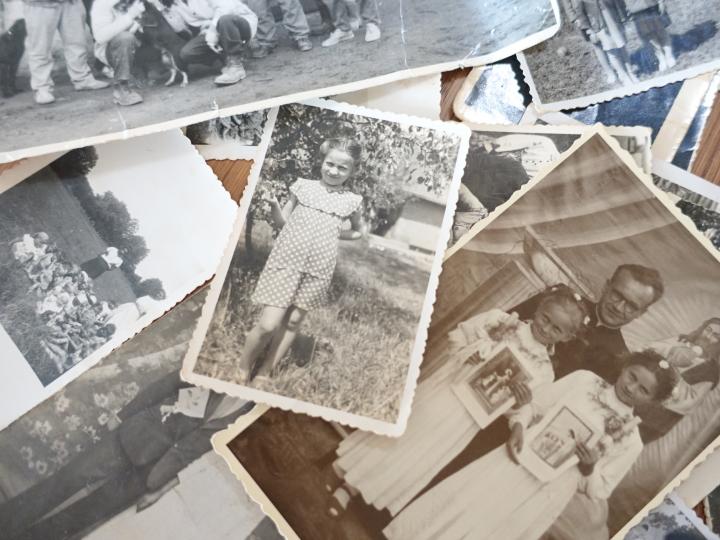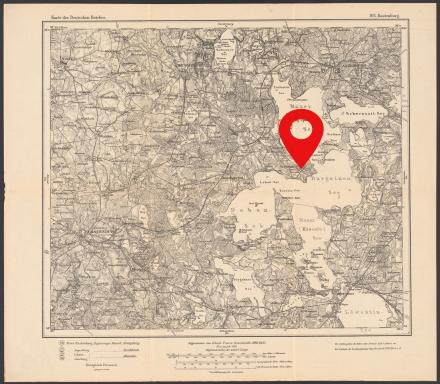Steinort Palace in northern Masuria was the seat of the noble Lehndorff family until 1945. The last Count, Heinrich von Lehndorff, was one of the conspirators of July 20, 1944. These stories tell of the fate of the East Prussian noble family and follow the lives of people who lived in the village, which is called Sztynort today. Others tell of German and Polish enthusiasts who are working to revive the run-down manor house. 17 biographical texts explore themes of expulsion and new beginnings, tragedy and awakening in this multi-ethnic region.
The story behind the project
Text
The project began with Agata Kern’s happy memories of her kindergarten in Sztynort, in socialist in the early 1970s. She would never forget this time. The simple joy of life, the stately rooms – in Lehndorff's castle, the "pałac", as the people of Sztynort called it.
Agata always treasured the photos of her kindergarten class. She kept in touch with some of the girls, even after they left for West Germany in 1989. Later, as a cultural advisor at the East Prussian State Museum, she would often visit with groups of schoolchildren and students. Year after year, she walked around the Baroque castle, which was empty since 1990 and had become increasingly derelict. "It was a magical place!" But suddenly, she no longer felt that magic; it had just become a huge stone box.
Poland
deu. Polen, pol. Polska
Poland is a state in Central Eastern Europe and is home to approximately 38 million people. The country is the sixth largest member state of the European Union. The capital and biggest city of Poland is Warsaw. Poland is made up of 16 voivodships. The largest river in the country is the Vistula (Polish: Wisła).
Agata always treasured the photos of her kindergarten class. She kept in touch with some of the girls, even after they left for West Germany in 1989. Later, as a cultural advisor at the East Prussian State Museum, she would often visit
Sztynort
deu. Steinort, deu. Groß Steinort
The village of Sztynort is located in the north of the Masurian Lake District on the Jez Peninsula between Jezioro Mamry, Jezioro Dargin and Jezioro Dobskie. Until 1928 the village was called Groß Steinort, then Steinort.


Agata’s kindergarten in the Lehndorff manor house, early 1970s. Agata Kern, Free access - no reuse
Agata’s kindergarten in the Lehndorff manor house, early 1970s. Agata Kern, Free access - no reuse
Text
When Antje Vollmer's book "Doppelleben. Heinrich und Gottliebe von Lehndorff im Widerstand gegen Hitler und von Ribbentrop" was published in 2010, Agata Kern was elated. She saw the book as an opportunity to make the importance of her hometown and the Lehndorffs of Steinort more widely known. She was deeply impressed by the daring of the two young aristocrats, Heinrich and Gottliebe.
Antje Vollmer's double portrait, which tells of the couple’s life, the years in the eye of the storm – Steinort was only a few kilometers away from the Führer's headquarters "Wolfsschanze" "Wolfsschanze" The "Wolf's Lair" was built during the Second World War and was one of the "Führer headquarters". The facility, including bunkers and numerous buildings, was above ground but camouflaged in a wooded area near the town of Rastenburg (now Kętrzyn). Hitler stayed there mainly from 1941 to 1944. Today, the ruins of the Wolf's Lair, which was demolished by the Wehrmacht during its retreat, are a tourist attraction. and Foreign Minister von Ribbentrop took up residence in the castle itself – met with an enthusiastic response in Germany and later also in Poland. It enriched and broadened our picture of the resistance movement within the aristocracy: Heinrich von Lehndorff, who was in fact quite an apolitical man, was completely different from the conspirators we usually hear about. In the book, Vollmer pays special attention to his wife Gottliebe and the fate of the traumatized family after 1945.
Antje Vollmer's double portrait, which tells of the couple’s life, the years in the eye of the storm – Steinort was only a few kilometers away from the Führer's headquarters "Wolfsschanze" "Wolfsschanze" The "Wolf's Lair" was built during the Second World War and was one of the "Führer headquarters". The facility, including bunkers and numerous buildings, was above ground but camouflaged in a wooded area near the town of Rastenburg (now Kętrzyn). Hitler stayed there mainly from 1941 to 1944. Today, the ruins of the Wolf's Lair, which was demolished by the Wehrmacht during its retreat, are a tourist attraction. and Foreign Minister von Ribbentrop took up residence in the castle itself – met with an enthusiastic response in Germany and later also in Poland. It enriched and broadened our picture of the resistance movement within the aristocracy: Heinrich von Lehndorff, who was in fact quite an apolitical man, was completely different from the conspirators we usually hear about. In the book, Vollmer pays special attention to his wife Gottliebe and the fate of the traumatized family after 1945.


Antje Vollmer at the East Prussian Regional Museum in Lüneburg giving a reading from “Doppelleben”, 2011. Ostpreußisches Landesmuseum, Free access - no reuse
Antje Vollmer at the East Prussian Regional Museum in Lüneburg giving a reading from “Doppelleben”, 2011. Ostpreußisches Landesmuseum, Free access - no reuse
Text
Vollmer's book inspired hope among the friends of Steinort Castle, who came together in 2009/2010. At that time, the castle passed from a private investor into the ownership of a foundation, the "Polsko-Niemiecka Fundacja Ochrony Zabytków Kultury". Despite all the setbacks, the rescue operation went ahead, and Agata Kern followed the progress with joy and trepidation.
This already outlines the essential elements of the project. Like the castle itself, it seemed to be patiently lying there, waiting to be discovered. One day the time had come: together with the author Ulla Lachauer, Agata Kern set to work, and the Copernico portal opened its doors.
This already outlines the essential elements of the project. Like the castle itself, it seemed to be patiently lying there, waiting to be discovered. One day the time had come: together with the author Ulla Lachauer, Agata Kern set to work, and the Copernico portal opened its doors.
Text
A Polish woman from Masuria, a German woman from Westphalia, each with her own unique knowledge and experience of East Prussia. They wanted to interview people with important connections to Steinort/Sztynort and tell their biographies, complementing these with other sources wherever possible.
Three chapters, three major perspectives: the fate of the aristocratic Lehndorff family and – as a counterpoint – the life stories of locals from the village, before and after 1945. In addition, portraits of activists and visionaries who are committed to the future of the village.
Three chapters, three major perspectives: the fate of the aristocratic Lehndorff family and – as a counterpoint – the life stories of locals from the village, before and after 1945. In addition, portraits of activists and visionaries who are committed to the future of the village.


Karin Gräfin von Dönhoff, Heinrich von Lehndorff’s niece, Sztynort 2021. Ulla Lachauer, Free access - no reuse
Karin Gräfin von Dönhoff, Heinrich von Lehndorff’s niece, Sztynort 2021. Ulla Lachauer, Free access - no reuse
Text
The interviews for the Lehndorff chapter proved difficult. Progress was hampered by illness, and, in some cases, interviewees were reluctant or shy to speak publicly about traumatic experiences.
Antje Vollmer's research, however, provided a foundation, as did the autobiographical interview with Vera "Veruschka" von Lehndorff, in which she recounted the life experiences of her mother Gottliebe and the four Lehndorff daughters after the end of the war. The role of the family narrator is played by Gottliebe and Heinrich’s grandson Verus von Plotho. The actress Hanna Schygulla, a longtime friend of Gottliebe von Lehndorff, recalls times they shared in the artists' colony in Peterskirchen.
Antje Vollmer's research, however, provided a foundation, as did the autobiographical interview with Vera "Veruschka" von Lehndorff, in which she recounted the life experiences of her mother Gottliebe and the four Lehndorff daughters after the end of the war. The role of the family narrator is played by Gottliebe and Heinrich’s grandson Verus von Plotho. The actress Hanna Schygulla, a longtime friend of Gottliebe von Lehndorff, recalls times they shared in the artists' colony in Peterskirchen.


Agata Kern interviewing Jurek Dacko, who lives with his family in the former Steinort school building. Ulla Lachauer, Free access - no reuse
Agata Kern interviewing Jurek Dacko, who lives with his family in the former Steinort school building. Ulla Lachauer, Free access - no reuse
Text
The village stories, on the other hand, came quite effortlessly. They bring to life the microcosm of Sztynort after 1945, the coexistence of autochthonous Masurians who had stayed behind, immigrants from the surrounding districts, the so-called "repatriates" from eastern Poland, and Ukrainians, who had been forced to resettle here – a multi-ethnic society typical of many villages in the region.
At the center of the socialist collective farming community stood the former Lehndorff castle, the "pałac". Among other things, it housed the local kindergarten, and its history shows how the various groups in the village have slowly grown together.
At the center of the socialist collective farming community stood the former Lehndorff castle, the "pałac". Among other things, it housed the local kindergarten, and its history shows how the various groups in the village have slowly grown together.


Hannah Wadle, social anthropologist and cultural activist, visits the construction site in the east wing, 2021. Ulla Lachauer, Free access - no reuse
Hannah Wadle, social anthropologist and cultural activist, visits the construction site in the east wing, 2021. Ulla Lachauer, Free access - no reuse
Text
Meanwhile, the visitors who have come to Sztynort to help save the castle also belong here. Their view as outsiders plays an important role, as does their understanding and support – and the life stories they bring with them.
Family stories of expulsion and dictatorship are interwoven with experiences of current global events; some people have come to Stzynort via England or Syria. What is it that inspires the civil engineer, the cultural activist, the manager, the songwriter?
People come here for many different reasons – some are tired of city life, others have a passion for sailing, business ideas, or are drawn to the mystery that emanates from the castle and surrounding parkland. Some have political motivations, believing that this place should serve German-Polish friendship. The memory of the resistance plot of July 20 is another drawcard, a counterpoint to the nearby "Wolf's Lair", that memorial to right-wing radicalism with its constant flurry of tourists.
Family stories of expulsion and dictatorship are interwoven with experiences of current global events; some people have come to Stzynort via England or Syria. What is it that inspires the civil engineer, the cultural activist, the manager, the songwriter?
People come here for many different reasons – some are tired of city life, others have a passion for sailing, business ideas, or are drawn to the mystery that emanates from the castle and surrounding parkland. Some have political motivations, believing that this place should serve German-Polish friendship. The memory of the resistance plot of July 20 is another drawcard, a counterpoint to the nearby "Wolf's Lair", that memorial to right-wing radicalism with its constant flurry of tourists.
Text
The biographical narratives each have their own subjective truth. Some lead into uncharted territory and will undoubtedly serve as fruitful material for future research projects. Private and regional sources have come to light, above all a large number of photographs, which are presented here for the first time.


Photographs from Sztynort, 1950s. Ulla Lachauer, Free access - no reuse
Photographs from Sztynort, 1950s. Ulla Lachauer, Free access - no reuse
Text
Some branches of our research led nowhere, such as the search for former servants of the Lehndorffs. Instead, by chance we happened upon the descendants of the Steinort teaching dynasty, the Puschke family. For over four generations, the Puschkes worked as schoolteachers here, occupying a special position between the noble castle and the local villagers. The Lehndorff family has also inherited a suitcase full of documents, including a letter from Gottliebe dating from 1947.
The fourth chapter of the project tells of the migration of objects – stolen, destroyed, expropriated, things that vanished and were found again. For example, the odyssey of a Rococo chest of drawers from the Lehndorff castle. Or the stories of inconspicuous everyday objects such as bricks, bowls, boxes, which changed places and owners over the years.
The fourth chapter of the project tells of the migration of objects – stolen, destroyed, expropriated, things that vanished and were found again. For example, the odyssey of a Rococo chest of drawers from the Lehndorff castle. Or the stories of inconspicuous everyday objects such as bricks, bowls, boxes, which changed places and owners over the years.


A champagne bucket belonging to the Lehndorff family. Ulla Lachauer, CC BY-NC-SA 4.0
A champagne bucket belonging to the Lehndorff family. Ulla Lachauer, CC BY-NC-SA 4.0


Christmas baubles of a Ukrainian family deported to Masuria from the Subcarpathian region. Ulla Lachauer, CC BY-NC-SA 4.0
Christmas baubles of a Ukrainian family deported to Masuria from the Subcarpathian region. Ulla Lachauer, CC BY-NC-SA 4.0
Text
May these seventeen stories help Steinort Castle and this remote Masurian region discover their place in Europe.
Text
Our thanks go out to all our interviewees for their stories and their trust. Dr. Gaby Huch, the historian responsible for the source edition "Lebenswelten Lehndorff", for generously contributing material, and for her patient professional guidance. Dr. Andreas Kossert, Dr. Joachim Mähnert and Dr. Ewa Lewandowska for their advice and support. Bernadeta Kuklinska, who accompanied us on the trips to Masuria as an interpreter. Cornelia Pieper, Consul General in Gdansk, for her tireless, contagious enthusiasm for Steinort. The "Fundacja Borussia" in Olsztyn, especially Kornelia Kurowska, for setting such an example and inspiring us in so many ways. The Lehndorff Society for its goodwill and its many contributions. Dr. Jörn Barfod, curator at the East Prussian State Museum, for his efforts in the archives. The author Jörn Jakob Rohwer with whom we had such stimulating conversations. Michael Meyer of the Kreisgemeinschaft Angerburg for his help with research. Andrzej Rzem-połuch from the Muzeum Warmii i Mazur in Olsztyn, who introduced us to paintings rescued from Steinort Castle. Professor Kilian Heck for providing valuable photos and Irene Brauer from the Marion Dönhoff Foundation, Jürgen Soetig, as well as Anke Eis from the Jäger Engineering Office. Lastly, we thank Marta Wojciechowska from the Museum in Kętrzyn for hosting the premiere of our project in the region.
Text
English translation: William Connor





